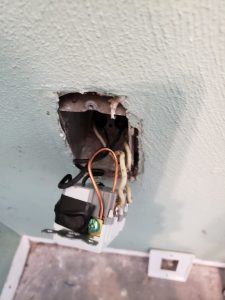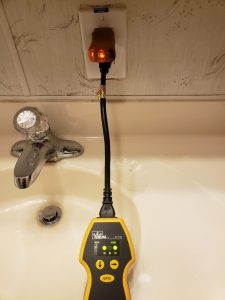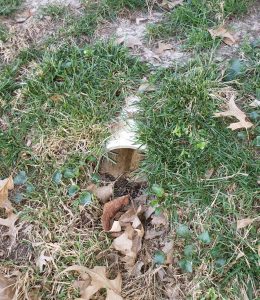10 Common Inspection Defects
Inspection defects are usually easy and inexpensive to repair. If the home seller or buyer is handy, they can do some at no cost. Here are some of the most common defects that can be resolved for less than $100.00. Knowing these ten common inspection defects may save your client time and money, whether you represent the buyer or the seller.
1 Torn and rotten plumbing vent seals
A torn plumbing boot can allow water into the attic creating fungal growth and rotten wood. When we talk about torn plumbing boots, most people’s first thought is, “will I need a new roof?” The truth is if it’s only a torn rubber boot, it can be repaired for between $10 and $15. The new rubber boot slides down over the existing plumbing vent pipe and seals the pipe.


2 Missing Tip-Over brackets
 Tip-over brackets could have prevented forty thousand injuries with a $15 to $20 bracket that comes with the stove but is rarely installed. New home or existing home, we rarely find these properly installed. Such a simple fix but still a common defect. These should be available from any appliance dealer.
Tip-over brackets could have prevented forty thousand injuries with a $15 to $20 bracket that comes with the stove but is rarely installed. New home or existing home, we rarely find these properly installed. Such a simple fix but still a common defect. These should be available from any appliance dealer.
3 Ungrounded Three Prong Receptacles

DIYer’s, flippers, handymen, and some homeowners will install three-prong receptacles on a two-wire circuit. This is commonly done to allow three-prong appliance cords to be used without the three to two adapter. False grounds are dangerous because the end-user expects a grounded circuit to protect them and is not there. See solution below
4 Three prong receptacles with “false” or “bootleg” grounds
In an attempt to make an ungrounded receptacle appear to be grounded, a jumper wire was attached (above on the left) to the neutral screw and the ground screw. A false or bootleg ground will cause a two-wire ungrounded circuit to appear to be grounded.
false or bootleg ground will cause a two-wire ungrounded circuit to appear to be grounded.
The picture on the left shows how a false ground is applied, and in the image on the right above is the standard three-prong tester most inspectors use. Because this is a severe safety issue, Hawley Home Inspections uses a much more expensive and accurate tester shown on the bottom in the picture on the right above. The more expensive tester will find false grounds many inspectors can miss. False grounds are a safety issue and must be corrected.

The National Electrical Code (NEC) allows for four easy fixes for three-prong receptacles on two-wire circuits:
- replace with two-prong receptacles (this solves nothing because the new owner will probably switch them back)
- Install a GFCI receptacle as the lead receptacle
- Install a GFCI breaker in the panel box for that circuit
- Install a dual purpose AFCI/GFCI breaker
Note: This protects against electrical shock but does not supply grounding (false grounds must be removed).
5 Missing or Inoperative GFCI protection
Another common inspection defect is missing or inoperative GFCI receptacles or GFCI breakers. GFCI protection was first required by the National Electrical Code (NEC) in 1971  for swimming pools and outdoor receptacles. GFCI receptacles are now required in bathrooms, over kitchen countertops, garages, boathouses and docks, crawlspaces, basements, utility, and laundry rooms, and within 6 feet of any sink. Hot tubs, spas, and whirlpool tubs must also have GFCI protection. GFCI devices should be checked monthly as recommended by the manufacturer.
for swimming pools and outdoor receptacles. GFCI receptacles are now required in bathrooms, over kitchen countertops, garages, boathouses and docks, crawlspaces, basements, utility, and laundry rooms, and within 6 feet of any sink. Hot tubs, spas, and whirlpool tubs must also have GFCI protection. GFCI devices should be checked monthly as recommended by the manufacturer.
Other Inspection Defects
6 Dedicated circuits are common inspection defects
The NEC no longer allows dedicated circuits in place of GFCI protection for sump pumps, sewer ejectors, and other appliances where GFCI protection is now required. We recommend using GFCI receptacles with built-in alarms for refrigerators and freezers in garages and basements, and these are good insurance for less than $20.00.
High water alarms for sump pumps and sewage ejectors are available for less than $20. For less than $60, you can even buy a power failure plugin that will send you a text message if the power is interrupted to a receptacle.
7 Open Holes/Slots in Breaker Panels
Other common inspection defects are open holes and missing breakers in panels. Other than the apparent danger to small children, open holes allow rodents, insects, and sometimes snakes to enter the breaker /fuse box. This fix is usually less than 50 cents per hole, and in addition to keeping kids and critters out, it also keeps sparks and possible fires contained to the panel.


This little guy came in through a hole that was not plugged.
8 ARC Fault Breakers
ARC fault breakers (AFCI) protect against electrical fires and have been required by the NEC in sleeping areas since 2002. Current safety standards now require AFCI protection in all occupied rooms that are not required to be GFCI protected. can be provided by Installing dual-purpose AFCI/GFCI breakers will give additional protection for two-wire circuits
9 Garage Doors
Garage door problems are often as simple as adjusting the reversing tension or properly adjusting the electric eyes.
Garage doors can be scary, but most of the common inspection defects we see are easy to fix. When the door closes, it should reverse within 1 ½ inch of the floor. A pressure reverse pressure sensor out of adjustment can be fixed for free. There should be a screw on the backside of the overhead garage door opener that can be adjusted. To test the pressure reverse lay, a 2×4 board flat on the floor under the center of the door and close the door. When the overhead door touches, it should go up on its own.
are easy to fix. When the door closes, it should reverse within 1 ½ inch of the floor. A pressure reverse pressure sensor out of adjustment can be fixed for free. There should be a screw on the backside of the overhead garage door opener that can be adjusted. To test the pressure reverse lay, a 2×4 board flat on the floor under the center of the door and close the door. When the overhead door touches, it should go up on its own.
While we know that the garage door springs rarely break, they are under tremendous tension, and if they fail, they can do a lot of harm. This owner had the right idea; he just forgot to run the safety cable through the spring! You can buy safety cables c for approximately $10-$20 per door.
they fail, they can do a lot of harm. This owner had the right idea; he just forgot to run the safety cable through the spring! You can buy safety cables c for approximately $10-$20 per door.
Safety eyes for the overhead garage door should be 3-6 inches off the floor, not mounted on the ceiling. You can buy replacement eye sensors for between $35-$45.
10 Gutters and Downspouts
Gutters should extend a minimum of 4 feet away from the foundation to help keep water from pooling at the foundation. Gutter extensions will run between $5-$15, depending on what kind you choose.


Buried downspout extensions should be solid pipes such as schedule 40 PVC because the corrugated pipes clog easier and are almost impossible to clean when clogged. It would be best to clean your gutters yearly, and buried extensions must be open to operate correctly.
10 common inspection defects bonus
If left alone, a loose toilet can lead to costly repairs. Loose toilets are most commonly found on concrete or ceramic tile floors. When a toilet is loose, you should remove the toilet, and install a new wax ring. While the toilet is pulled, inspect the flange and subfloor around it. A new wax ring and toilet bolts will cost approximately $4-$12.
These solutions are general and are not to be considered the only solution. If you are not comfortable with minor home repairs, a competent handyman can complete most of these.

